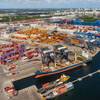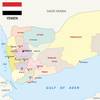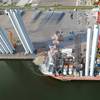The guided-missile cruiser USS Lake Champlain (CG 57) moves thru the Bay of Bengal after making a port call in Singapore. Lake Champlain is part of the Ronald Reagan Carrier Strike Group, currently deployed in support of the global war on terrorism and maritime security operations (MSO). U.S. Navy photo by Photographer's Mate 2nd Class Christopher Brown (RELEASED)
While there is a ring of steel around the Iraqi oil terminal platforms in the Northern Persian Gulf, small rubber boats with special boat crews do much of the heavy lifting for security and stability in the area.
Coalition ships move continuously around the Al Basra Oil Terminal and the Khawr al Amaya Oil Terminal, and each sends out small boat crews aboard rigid-hulled inflatable boats to conduct VBSS (visit, board, search and seizure) missions.
"They are the 'beat cops' for the area," said Capt. Pat Roane, USS Lake Champlain's (CG 57) captain. "They reach out from the ships and serve a variety of functions."
The crews run the range and fulfill a variety of missions. Sailors from U.S., British and Australian ships volunteer to serve on these crews. Lake Champlain, for example, has two crews pulled from volunteers around the ship.
"We received training before we left San Diego," said Operations Specialist 1st Class Jesse Hayden. "On days when we are not needed, we work in our specialties. This is sort of on the order of 'other duty as assigned.'"
Personnel Specialist Seaman Jared Wilmouth is a search-and-rescue swimmer with the team. "You really see you are making a difference on these teams," he said.
All coalition ships have this capability. American, British and Australian ships are always a part of Coalition Task Force 58. Other countries' ships join when available.
The teams provide a variety of capabilities.
The platforms are in the middle of a fishing ground, and there is an exclusion area around the platforms. Fishing dhows come right up to the line. The teams interact constantly with Iraqi, Kuwaiti and Iranian fishermen.
"The teams go out and talk to the fishermen," Doane said. "That way, we know who belongs there and who is there for other purposes."
Royal Navy Cmdr. Steve Dainton, commander of St. Albans, said the conversations are noncontroversial, but it does let the fishermen know that the coalition is present. "We talk to them about where the good fishing grounds are, who is there, conditions on shore, how often they fish - just basic chitchat to gain their confidence," he said. "We also talk to them to gain any information at all related to the wider coalition mission."
The teams also board oil takers that are lined up to take on fuel from the platforms. The teams often have to climb rope ladders 100 feet up the sides of the tankers. They are wearing ballistic vests, carrying weapons and a full load of ammunition.
"When we first started, I thought some of my mates were going to have a heart attack," said Royal Australian Navy Lt. Cmdr. John Early, the executive officer of HMAS Ballarat (FFH 155). "But now they scamper up the sides."
The fishermen have generally reacted positively to the coalition presence. "One thing that surprised us was how much they value coming in to this area because they know we provide law and order," said Ballarat's captain Cmdr. Mal Wise. "They know they are not going to get shook down with us here."
Doane said the mission is a lot like what civil affairs personnel do on land in Afghanistan or Iraq. "You get to know your neighborhood," he said. "You know where the good members of the neighborhood go, and where the ones with ulterior motives hang out."
Source: NavNews
By Jim Garamone, American Forces Press Service
Featured videos

Inside the Electrified Truckable Tug

Inmarsat Enhances Service to Drive Digitalization

Tracking Foreign Vessels Working in the U.S. Jones Act Market
Subscribe for
Maritime Reporter E-News
Maritime Reporter E-News is the maritime industry's largest circulation and most authoritative ENews Service, delivered to your Email five times per week









